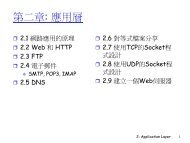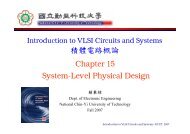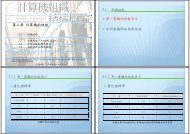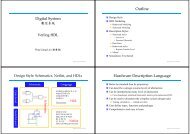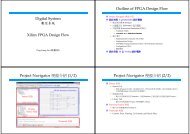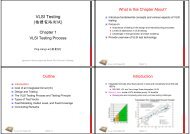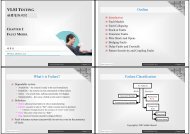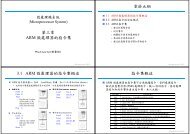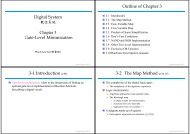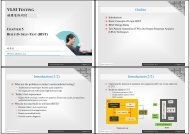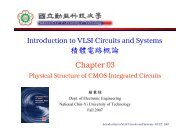Chapter 3 Testability Measure.pdf
Chapter 3 Testability Measure.pdf
Chapter 3 Testability Measure.pdf
Create successful ePaper yourself
Turn your PDF publications into a flip-book with our unique Google optimized e-Paper software.
An Example of Combinational Circuit (2/3)<br />
An Example of Combinational Circuit (3/3)<br />
First, calculate the TM for the nodes on the<br />
second level, F, H, and G<br />
1.CC1(F)=CC1(A)+CC1(B)+CC1(C)+1=4<br />
2.CC0(F)=min{CC0(A), CC0(B), CC0(C)}+1=2<br />
3.CC1(H)=min{CC0(A), CC0(B)}+1=2<br />
4.CC0(H)=CC1(A)+CC1(B)+1=3<br />
5.CC1(G)=CC0(C)+1=2<br />
6.CC0(G)=CC1(C)+1=2<br />
These TM values are then used in calculating<br />
the primary output controllability<br />
7.CC1(Y)=min{CC1(F), CC1(H)}+1=3<br />
8.CC0(Y)=CC0(F)+CC0(H)+1=6<br />
9.CC1(Z)=min{CC0(H), CC0(G)}+1=3<br />
10.CC0(Z)=CC1(H)+CC1(G)+1=5<br />
A<br />
B<br />
C<br />
G1<br />
G2<br />
G3<br />
H<br />
F<br />
G<br />
G4<br />
G5<br />
Y<br />
Z<br />
The observability of a node indicates the<br />
effort needed to observe the logic value on<br />
the node at a primary output<br />
For second level,<br />
11.CO Y (F)=CO(Y)+CCO(H)+1=5<br />
12.CO Z (G)=CO(Z)+CC1(H)+1=4<br />
13.CO Y (H)=CO(Y)+CC0(F)+1=4<br />
14.CO Z (H)=CO(Z)+CC1(G)+1=5<br />
For primary inputs,<br />
15. CO Z (C)=CO Z (G)+1=[CO(Z)+CC1(H)+1]+1 =5<br />
(line C)<br />
16. CO Y (C)=CO Y (F)+CC1(A)+CC1(B)+1<br />
=[CO(Y)+CC0(H)+1]+CC1(A)+CC1(B)+1=8<br />
(line C)<br />
17.CO YH (A)=CO Y (H)+CC1(B)+1=6<br />
18.CO Z (A)=CO Z (H)+CC1(G)+1=8<br />
A<br />
B<br />
C<br />
CC1(F)=4<br />
CC0(F)=2<br />
CC1(H)=2<br />
CC0(H)=3<br />
CC1(G)=2<br />
CC0(G)=2<br />
CC1(Y)=3<br />
CC0(Y)=6<br />
CC1(Z)=3<br />
CC0(Z)=5<br />
G1<br />
G2<br />
G3<br />
H<br />
F<br />
G<br />
G4<br />
G5<br />
Y<br />
Z<br />
P.L.Lai, VLSI Testing 2010 <strong>Chapter</strong> 3-13<br />
P.L.Lai, VLSI Testing 2010 <strong>Chapter</strong> 3-14<br />
SCOAP for Sequential Circuit (1/5)<br />
Sequential controllability and observability calculation<br />
The combinational and sequential<br />
controllability measures of signal d:<br />
CC0(d)=min{CC0(a), CC0(b)}+1<br />
SC0(d)=min{SC0(a), SC0(b)}<br />
CC1(d)=CC1(a)+CC1(b)+1<br />
SC1(d)=SC1(a)+SC1(b)<br />
SCOAP for Sequential Circuit (2/5)<br />
The combinational and sequential controllability and<br />
observability measures of q:<br />
<br />
<br />
<br />
<br />
CC0(q)=min{CC0(d)+CC0(CK)+CC1(CK)+CC0(r), CC1(r)+CC0(CK)}<br />
SC0(q)=min{SC0(d)+SC0(CK)+SC1(CK)+SC0(r)+1, SC1(r)+SC0(CK)}<br />
CC1(q)=CC1(d)+CC0(CK)+CC1(CK)+CC0(r)<br />
SC1(q)=SC1(d)+SC0(CK)+SC1(CK)+SC0(r)+1<br />
SCOAP sequential circuit example<br />
P.L.Lai, VLSI Testing 2010 <strong>Chapter</strong> 3-15<br />
P.L.Lai, VLSI Testing 2010 <strong>Chapter</strong> 3-16



